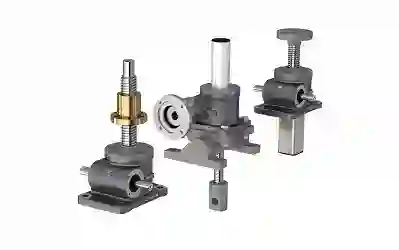Pulling screw jacks, the sturdy workhorses of linear motion, excel at lifting and maneuvering heavy loads. But what if you need to handle an exceptionally heavy object that surpasses the capacity of a single jack? Here’s where the concept of load convergence comes in, leveraging the power of multiple pulling screw jacks working in unison to tackle these colossal challenges.
The Power of Many: The Essence of Load Convergence
- Distributing the Load: Load convergence essentially involves utilizing multiple pulling screw jacks strategically positioned to lift a single, massive object. The weight of the object is then distributed amongst these jacks, allowing them to collectively handle a load exceeding the capacity of any single jack.
- Synchronized Operation: For successful load convergence, the pulling screw jacks must be precisely synchronized. This ensures that all jacks lift the object at the same rate and apply equal force, preventing uneven lifting or potential damage to the object.
Common Load Convergence Techniques:
- Multiple Jacks on a Lifting Beam: In this technique, several pulling screw jacks are mounted on a sturdy lifting beam. The object is then attached to the lifting beam, and all jacks operate simultaneously to lift the object in a controlled and uniform manner.
- Truss System with Pulling Screw Jacks: A truss system can be employed to distribute the load across multiple pulling screw jacks. The jacks are positioned at specific points on the truss, and the object is lifted by synchronizing the operation of all jacks.
Benefits of Load Convergence:
- Handling Excessively Heavy Loads: This technique allows you to surpass the limitations of a single screw jack, enabling the lifting and maneuvering of objects exceeding the capacity of any individual jack in your system.
- Enhanced Stability: Distributing the load across multiple jacks improves overall stability during the lifting process. This minimizes the risk of the object tilting or slipping, ensuring greater safety and control.
- Redundancy: Incorporating multiple jacks introduces an element of redundancy into the system. If one jack malfunctions, the others can potentially compensate and complete the lifting operation, depending on the specific load distribution and safety factors involved.
Considerations for Implementing Load Convergence:
- Structural Integrity: The lifting beam or truss system used for load convergence must be structurally sound and capable of handling the combined lifting capacity of all the jacks involved.
- Synchronization System: A reliable synchronization system is crucial to ensure all jacks operate simultaneously and apply equal force. This can be achieved through electronic control systems or mechanical linkages.
- Safety Measures: Even with load convergence, safety remains paramount. Always implement proper lifting procedures, overload protection mechanisms, and have qualified personnel oversee the operation.
Conclusion:
Load convergence is a powerful technique that transforms individual pulling screw jack types into a team capable of tackling monumental lifting tasks. By understanding the principles and implementing them with careful planning and proper safety measures, you can leverage the combined strength of multiple jacks to conquer even the most heavyweight challenges.









